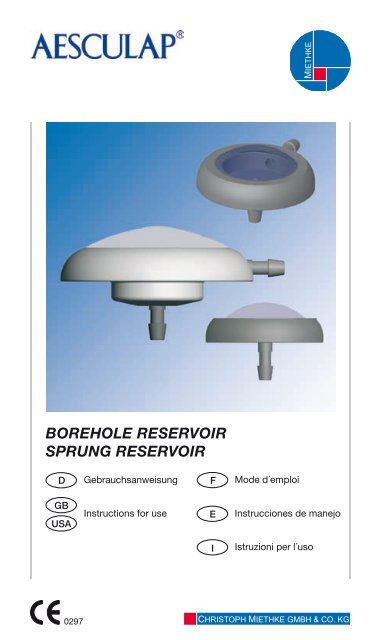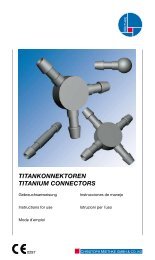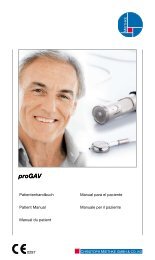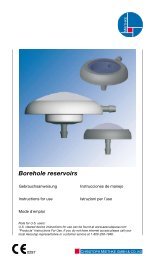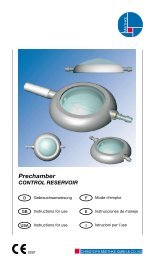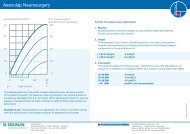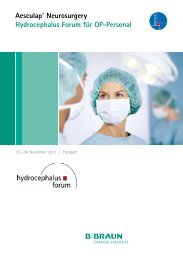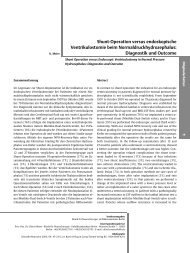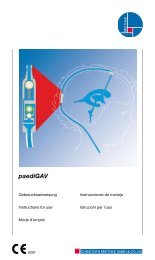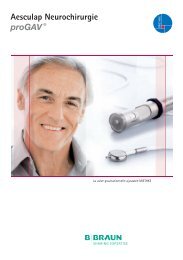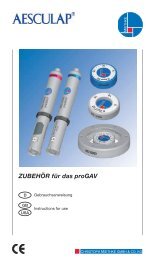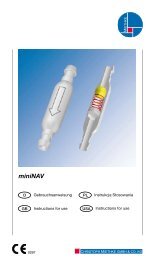borehole reservoir sprung reservoir - Christoph Miethke GmbH & Co ...
borehole reservoir sprung reservoir - Christoph Miethke GmbH & Co ...
borehole reservoir sprung reservoir - Christoph Miethke GmbH & Co ...
You also want an ePaper? Increase the reach of your titles
YUMPU automatically turns print PDFs into web optimized ePapers that Google loves.
BOREHOLE RESERVOIR<br />
SPRUNG RESERVOIR<br />
D<br />
GB<br />
USA<br />
0297<br />
Gebrauchsanweisung<br />
Instructions for use<br />
F Mode d´emploi<br />
E<br />
I<br />
MIETHKE<br />
Instrucciones de manejo<br />
Istruzioni per l´uso<br />
CHRISTOPH MIETHKE GMBH & CO. KG
BOHRLOCHRESERVOIR/SPRUNGRESERVOIR<br />
Indikation<br />
Das BOHRLOCHRESERVOIR dient zur<br />
Liquorentnahme, Medikamentenapplikation<br />
und Druckkontrolle bei der Behandlung<br />
des Hydrocephalus.<br />
Beschreibung<br />
Eine Möglichkeit zur Behandlung des Hydrocephalus<br />
ist die Implantation eines<br />
Shuntsystems, das die Ableitung des Liquor<br />
ceresbrospinalis aus den Hirnkammern<br />
in den geeigneten Körperbereich<br />
(meist den Bauchraum) gewährleistet.<br />
Dieses Shuntsystem besteht aus mehreren<br />
Kathetern und einem Druckventil.<br />
Zusätzlich kann das BOHRLOCHRE-<br />
SERVOIR im Bohrloch der Schädeldecke<br />
positioniert werden. Es bietet die Möglichkeit,<br />
den intraventrikulären Druck zu<br />
messen, Medikamente zu injizieren und<br />
eine Ventilkontrolle durchzuführen. Der<br />
stabile Titanboden verhindert ein mögliches<br />
Durchstechen des Bodens. Eine<br />
Punktion sollte möglichst senkrecht zur<br />
Reservoiroberfläche mit einer Kanüle von<br />
max. Ø 0.9 mm erfolgen. Es kann ohne<br />
Einschränkug 0 mal punktiert werden.<br />
Das SpRungRESERVOIR ermöglicht<br />
durch ein Rückschlagventil im Boden zusätzlich,<br />
den Liquor in die ableitende Richtung<br />
zu pumpen und damit sowohl eine<br />
Kontrolle des distalen Drainageanteils als<br />
auch des Ventrikelkatheters durchzuführen.<br />
Während des Pumpvorganges ist der<br />
Zugang zum Ventrikelkatheter verschlossen.<br />
Das Volumen pro Pumpvorgang beträgt<br />
ca. 0,18 ml. Der Öffnungsdruck des<br />
Shuntsystems wird durch den Einsatz des<br />
SpRungRESERVOIRS nicht erhöht.<br />
Warnhinweis<br />
Durch häufiges Pumpen des SPRUNG-<br />
RESERVOIRS kann es zu einer übermäßigen<br />
Drainage und damit zu unphysiologischen<br />
Druckverhältnissen<br />
kommen. Der Patient sollte über diese<br />
Gefahr aufgeklärt werden.<br />
MIETHKE<br />
Das BOHRLOCHRESERVOIR kann in<br />
verschiedenen Varianten (einzeln oder im<br />
Set) und als Bohrlochport bestellt werden.<br />
Der Bohrlochport besitzt keine seitliche<br />
Katheteranschlussmöglichkeit. Auf<br />
die Größe des kindlichen Schädels angepasst<br />
steht ein BOHRLOCHRESERVOIR<br />
und ein Bohrlochport für die pädiatrische<br />
Anwendung zur Verfügung.<br />
Implantation<br />
Der Ventrikelkatheter wird mit Hilfe eines<br />
Mandrins implantiert. Nach Anschluss an<br />
das BOHRLOCHRESERVOIR ist der Katheter<br />
mit einer Ligatur zu sichern.<br />
Die Reservoire sind für Katheter mit einem<br />
Innendurchmesser von ca. 1,2 mm und<br />
einem Außendurchmesser von ca. 2,5<br />
mm ausgelegt. Bei der Implantation eines<br />
BOHRLOCHRESERVOIRS ohne distalen<br />
Katheter ist darauf zu achten, dass der<br />
ableitende Katheter ebenfalls durch eine<br />
Ligatur gesichert wird.<br />
BOHRLOCHRESERVOIR<br />
Es wird ein Bohrloch mit einem Durchmesser<br />
von 10 mm empfohlen. Da der<br />
Ventrikelkatheter etwas in dem BOHR-<br />
LOCHRESERVOIR verschwindet, lässt<br />
sich die notwendige Ligatur sehr sicher<br />
anbringen (siehe Abb. 1).<br />
ø = 9,5 mm<br />
Abb. 1: BOHRLOCHRESERVOIR<br />
D<br />
zusätzliche<br />
Sicherheit
D<br />
BOHRLOCHRESERVOIR für die pädiatrische<br />
Anwendung<br />
Im Gegensatz zum Standardbohrloch<strong>reservoir</strong><br />
besitzt das BOHRLOCHRESER-<br />
VOIR für die pädiatrische Anwendung<br />
keinen Absatz am Reservoirboden. Der<br />
Außendurchmesser ist deutlich kleiner.<br />
SpRungRESERVOIR<br />
Durch ein zusätzliches Rückschlagventil<br />
im Boden des SpRungRESERVOIRS ist<br />
es möglich, den Liquor in die ableitende<br />
Richtung zu pumpen und damit sowohl<br />
eine Kontrolle des distalen Drainageanteils<br />
(Reservoir schwer ausdrückbar) als<br />
auch des Ventrikelkatheters (Reservoir<br />
füllt sich nach Ausdrücken nicht) durchzuführen<br />
(siehe Abb. 2).<br />
Abb. 2: SpRungRESERVOIR<br />
Wiederholungsimplantation<br />
Produkte, die bereits implantiert waren,<br />
dürfen nicht bei einem anderen Patienten<br />
erneut implantiert werden.<br />
Verträglichkeit mit diagnostischen<br />
Verfahren<br />
Das BOHRLOCHRESERVOIR und das<br />
SpRungRESERVOIR wie auch - wenn<br />
vorhanden - der distale Katheter bestehen<br />
aus den nicht magnetischen Werkstoffen<br />
Titan, Saphir und Silikon. Kernspinreso-<br />
BOHRLOCHRESERVOIR/SPRUNGRESERVOIR<br />
Rückschlagventil<br />
nanzuntersuchungen oder computertomographische<br />
Untersuchungen können<br />
ohne Beeinträchtigung durchgeführt<br />
werden. Die Reservoire sind MR sicher<br />
(ASTM-F250 -05). Die mitgelieferten<br />
Katheter sind MR kompatibel. Umlenker<br />
oder Konnektoren sind MR sicher.<br />
Vorsichtsmaßnahmen<br />
Nach der Implantation müssen die Patienten<br />
sorgfältig überwacht werden.<br />
Hautrötungen und Spannungen im Bereich<br />
des Drainagegewebes können ein<br />
Anzeichen von Infektionen am Shuntsystem<br />
sein. Symptome wie Kopfschmerzen,<br />
Schwindelanfälle, geistige Verwirrtheit<br />
oder Erbrechen treten häufig bei einer<br />
Shuntdisfunktion auf. Diese Anzeichen,<br />
wie auch eine Leckage am Shuntsystem,<br />
erfordern den sofortigen Austausch der<br />
Shuntkomponente oder auch des gesamten<br />
Shuntsystems.<br />
Sterilisation<br />
Die Produkte werden unter strenger Kontrolle<br />
mit Dampf sterilisiert. Durch die<br />
Doppel-Verpackung in Steriltüten ist eine<br />
fünfjährige Sterilität gewährleistet. Das<br />
jeweilige Verfallsdatum ist auf der Verpackung<br />
angegeben. Bei Beschädigung der<br />
Verpackung dürfen die Produkte auf keinen<br />
Fall verwendet werden.<br />
Erneute Sterilisation<br />
Für die Funktionssicherheit von resterilisierten<br />
Produkten kann keine Garantie<br />
übernommen werden.
BOHRLOCHRESERVOIR/SPRUNGRESERVOIR<br />
Medizinprodukteberater<br />
Die <strong>Christoph</strong> <strong>Miethke</strong> <strong>GmbH</strong> & <strong>Co</strong>. KG<br />
benennt entsprechend den Forderungen<br />
der Medizinprodukterichtlinie 9 / 2/EEC<br />
vom 02. August 199 Medizinprodukteberater,<br />
die Ansprechpartner für alle produktrelevanten<br />
Fragen sind:<br />
Dipl.-Ing. <strong>Christoph</strong> <strong>Miethke</strong><br />
Dipl.-Ing. Roland Schulz<br />
<strong>Christoph</strong> <strong>Miethke</strong> <strong>GmbH</strong> & <strong>Co</strong>. KG<br />
Ulanenweg 2<br />
D-1 69 Potsdam<br />
Tel.:+ 9(0) 7000 MIETHKE oder<br />
Tel.:+ 9 (0) 1 6208 -0<br />
Fax:+ 9 (0) 1 6208 - 0<br />
e-mail: info@miethke.com<br />
Bei Rückfragen wenden Sie sich bitte an:<br />
AESCULAP AG & CO. KG<br />
Am Aesculap Platz<br />
D-785 2 Tuttlingen<br />
Tel.:+ 9 (0) 7 61 95-0<br />
Fax:+ 9 (0) 7 61 95-26 00<br />
e-mail: information@aesculap.de<br />
Forderungen der Medizinprodukterichtlinie<br />
RL 93/42/EEC<br />
Das Medizinproduktegesetz fordert die<br />
umfassende Dokumentation des Verbleibs<br />
von medizinischen Produkten, die<br />
am Menschen zur Anwendung kommen,<br />
insbesondere für Implantate. Die individuelle<br />
Kenn-Nummer des implantierten<br />
Ventils sollte aus diesem Grunde in der<br />
Krankenakte des Patienten vermerkt werden,<br />
um eine lückenlose Rückverfolgbarkeit<br />
zu gewährleisten.<br />
MIETHKE<br />
Kommentar zur Gebrauchsanweisung<br />
Die hier ausgeführten Beschreibungen<br />
basieren auf den bisher vorliegenden klinischen<br />
Erfahrungen. Es liegt in der Hand<br />
des Chirurgen, entsprechend seiner Erfahrung<br />
und der chirurgischen Praxis auf<br />
eigene Verantwortung das OP-Prozedere<br />
zu ändern.<br />
Allgemeine Informationen<br />
Hersteller<br />
Produktbezeichnung<br />
Verwendungszweck<br />
D<br />
<strong>Christoph</strong> <strong>Miethke</strong><br />
<strong>GmbH</strong> & <strong>Co</strong>. KG<br />
BOHRLOCH-<br />
RESERVOIR /<br />
SpRung-<br />
RESERVOIR<br />
Behandlung des<br />
Hydrocephalus<br />
Zum einmaligen Gebrauch bestimmt<br />
Trocken und sauber lagern<br />
Skizze mit äußeren Abmaßen:<br />
normal:<br />
ø 20 mm<br />
pädiatrisch:<br />
ø 1 mm<br />
Höhe , mm<br />
Höhe 2,9 mm<br />
5
6<br />
D<br />
Varianten<br />
BOHRLOCHRESERVOIR/SPRUNGRESERVOIR<br />
BOHRLOCHRESERVOIR BOHRLOCHRESERVOIR BOHRLOCHPORT<br />
mit distalem Katheter<br />
BOHRLOCHRESERVOIR BOHRLOCHRESERVOIR BOHRLOCHPORT<br />
für pädiatrische für pädiatrische für pädiatrische<br />
Anwendung Anwendung Anwendung<br />
mit distalem Katheter<br />
SPRUNGRESERVOIR SPRUNGRESERVOIR ETOURESERVOIR<br />
mit distalem Katheter<br />
Anschlusstülle ist in unterschiedlichen<br />
Winkeln einstellbar<br />
BOHRLOCHRESERVOIR- und SPRUNGRESERVOIR-SET<br />
oder<br />
BOHRLOCHRESERVOIR- und BOHRLOCHPORT-SET für pädiatrische<br />
Anwendung<br />
oder<br />
Maßstab 1:1
BOREHOLE RESERVOIR/SPRUNG RESERVOIR<br />
Indications<br />
The BOREHOLE RESERVOIR is used in<br />
cases of hydrocephalus to remove cerebrospinal<br />
fluid, administer medications and<br />
monitor pressure.<br />
Description<br />
One possible treatment in cases of hydrocephalus<br />
is the implantation of a<br />
shunt system that achieves drainage of<br />
cerebrospinal fluid from the ventricles of<br />
the brain to an appropriate region of the<br />
body (in most instances to the abdominal<br />
cavity). This shuntsystem consists of<br />
a series of catheters and a differential<br />
pressure valve. In addition, the option of<br />
positioning the BOREHOLE RESERVOIR<br />
in the <strong>borehole</strong> of the cranium also exists.<br />
It then becomes possible to measure intraventricular<br />
pressure, inject medication<br />
and check the status of the valve. Its solid<br />
titanium base is highly puncture-resistant.<br />
A puncture of the fLuSHIng RESERVOIR<br />
or the COntROL RESERVOIR should be<br />
performed as perpendicular to the <strong>reservoir</strong><br />
surface as possible with a cannula of<br />
max. 0,9 mm. 0 times of punctures are<br />
able without any restrictions.<br />
With the SpRung RESERVOIR it is possible<br />
to flush CSF towards the valve due<br />
to a nonreturn valve in the bottom of the<br />
<strong>reservoir</strong>. By this mechanism a flow in<br />
the direction of the ventricular catheter is<br />
avoided during the pumping procedure.<br />
The volume per pump procedure is approx.<br />
0.18 ml. The opening pressure of the<br />
shuntsystem is not increased by the implantation<br />
of the SpRung RESERVOIR.<br />
Caution<br />
Frequent pumping of the SPRUNG<br />
RESERVOIR can lead to an excessive<br />
drainage and thus to unphysiological<br />
pressure situations. The patient<br />
should be informed about the risk.<br />
Nothing may be passed through the<br />
BOREHOLE RESERVOIR. A puncture<br />
should be performed as perpendicular to<br />
MIETHKE<br />
USA<br />
GB<br />
the <strong>reservoir</strong> surface as possible with a<br />
cannula whose maximum size is G 21.<br />
The BOREHOLE RESERVOIR is available<br />
in various product configurations (individually<br />
or as a set) and as a BOREHOLE<br />
PORT. The BOREHOLE PORT doesn´t<br />
have a lateral connector for a distal catheter.<br />
A BOREHOLE RESERVOIR and<br />
BOREHOLE PORT for pediatric application<br />
adapted to the size of children´s<br />
skulls are also available.<br />
Implantation<br />
The ventricle catheter is implanted with<br />
the aid of a introducing stylet. After being<br />
connected to the BOREHOLE RESER-<br />
VOIR the catheter is fixed with a ligature.<br />
The <strong>reservoir</strong>s are intended for use with<br />
catheters with an inner diameter of approx.<br />
1.2 mm and an outer diameter<br />
of approx. 2.5 mm. When implanting a<br />
BOREHOLE RESERVOIR without a distal<br />
catheter, care must be taken to ensure<br />
that the drainage catheter is also fixed in<br />
place with the aid of a ligature.<br />
BOREHOLE RESERVOIR<br />
It is recommended that a <strong>borehole</strong> with a<br />
diameter of 10 mm be performed. Owing<br />
to the fact that the ventricle catheter<br />
practically disappears in the BOREHOLE<br />
RESERVOIR, the requisite ligature can be<br />
made in a very secure fashion (see Fig.<br />
1).<br />
ø = 9,5 mm<br />
fig. 1 BOREHOLE RESERVOIR<br />
additional<br />
security<br />
7
8<br />
GB USA<br />
BOREHOLE RESERVOIR for pediatric<br />
application<br />
Unlike the standard BOREHOLE RE-<br />
SERVOIR, the BOREHOLE RESERVOIR<br />
for pediatric application does not have<br />
an additional reduction at the bottom of<br />
the <strong>reservoir</strong>. The outer diameter is much<br />
smaller.<br />
SpRung RESERVOIR<br />
As additional new feature of the SpRung<br />
RESERVOIR CSF can be flush towards<br />
the valve due to a nonreturn valve in the<br />
bottom of the <strong>reservoir</strong>. By this mechanism<br />
a flow in the direction of the ventricular<br />
catheter is avoided during the pumping<br />
procedure. The opening pressure of<br />
the shuntsystem is not increased by the<br />
implantation of the SpRung RESERVOIR<br />
(see Fig. 2).<br />
fig. 2 SpRung RESERVOIR<br />
Reimplantation<br />
Under no circumstances should products<br />
had have previously been implanted in<br />
one patient be subsequently reimplanted<br />
in another.<br />
<strong>Co</strong>mpatibility with diagnostic procedures<br />
Like the distal catheter (when applied),<br />
the BOREHOLE RESERVOIR and the<br />
SpRung RESERVOIR consists of the<br />
nonmagnetic substances titanium, sapphire<br />
and silicone. <strong>Co</strong>nsequently, the<br />
<strong>reservoir</strong> and catheters will not interfere<br />
with either nuclear magnetic resonance or<br />
computer tomographic procedures.<br />
BOREHOLE RESERVOIR/SPRUNG RESERVOIR<br />
nonreturn valve<br />
The BOREHOLE RESERVOIR and the<br />
SpRung RESERVOIR are MRI safe<br />
(ASTM-F250 -05). The provided catheters<br />
are MRI compatible. Deflectors and<br />
connectors are MRI safe.<br />
Safety measures<br />
Following implantation of a shunt system,<br />
the patient´s condition should be carefully<br />
and thoroughly monitored. Inflammation<br />
and tension around the drainage tissues<br />
could possibly be a sign of infection in<br />
the shunt system. Symptoms such as<br />
headache, dizziness, disorientation or vomiting<br />
often occur in cases of shunt dysfunction.<br />
In the event such symptoms occur<br />
or if there is any leakage in the shunt<br />
system, either individual shunt system<br />
components or the entire shunt system<br />
must be replaced without delay.<br />
Sterilization<br />
All products are carefully and thoroughly<br />
sterilized. Owing to the fact that the products<br />
are packaged in two layers of sterile<br />
packaging, five years of sterility are<br />
guaranteed. The expiration date for each<br />
item is indicated on the package. If the<br />
packaging is damaged in any way, the<br />
product should not be used under any<br />
circumstances.<br />
Resterilization<br />
The functional safety and reliability of<br />
resterilized products cannot be guaranteed.<br />
Requirements of the MDD 93/42/<br />
EEC<br />
The Medical products law calls for the<br />
comprehensive documentation of the<br />
whereabouts of medical products that<br />
are applied in human beings, especially<br />
the whereabouts of implants. For this reason,<br />
the individual identification numbers<br />
of any implanted valves are to be noted in
BOREHOLE RESERVOIR/SPRUNG RESERVOIR<br />
patients‘ records, so that in the event of<br />
any inquiries, the implant can be traced<br />
without any difficulties. Each valve is outfitted<br />
with a sticker for this purpose.<br />
Note on the instructions for use<br />
The descriptions and explanations given<br />
in this document are based on the clinical<br />
experience available to date. It is for the<br />
surgeon to decide if surgical procedures<br />
should be changed according to his or<br />
her experience and to surgical practice.<br />
Medical products consultant<br />
In compliance with the requirements of<br />
the European law MDD 9 / 2/EEC, <strong>Christoph</strong><br />
<strong>Miethke</strong> <strong>GmbH</strong> & <strong>Co</strong>. KG names<br />
medical product consultants as the individuals<br />
to be addressed with all queries<br />
concerning the products:<br />
Dipl.-Ing. <strong>Christoph</strong> <strong>Miethke</strong><br />
Dipl.-Ing. Roland Schulz<br />
<strong>Christoph</strong> <strong>Miethke</strong> <strong>GmbH</strong> & <strong>Co</strong>. KG<br />
Ulanenweg 2<br />
D-1 69 Potsdam<br />
Phone: + 9(0) 7000 6 8 5 or<br />
Phone: + 9(0) 1 620 8 0<br />
Fax: + 9(0) 1 620 8 0<br />
e-mail: info@miethke.com<br />
Please address any enquiries to:<br />
AESCULAP AG & CO. KG<br />
Am Aesculap Platz<br />
D-785 2 Tuttlingen<br />
Phone: + 9 (0) 7 61 95-9<br />
Fax: + 9 (0) 7 61 95-26 00<br />
e-mail: information@aesculap.de<br />
Service address in the US<br />
AESCULAP Inc.<br />
Attn. AESCULAP Technical Services<br />
615 Lambert Pointe Road<br />
Hazelwood, MO, 6 0 2<br />
MIETHKE<br />
USA<br />
AESCULAP Repair Hotline<br />
Phone: +1 (800) 21 - 92<br />
Fax: +1 ( 1 ) 895- 20<br />
GB<br />
Distributor in the US/ <strong>Co</strong>ntact in Canada<br />
AESCULAP Inc.<br />
77 <strong>Co</strong>rporate Parkway<br />
Center Valley, PA 180<br />
Phone: +1-800-282-9000<br />
www.aesculapusa.com<br />
General information<br />
Manufacturer<br />
Product name<br />
Intended use<br />
<strong>Christoph</strong> <strong>Miethke</strong><br />
<strong>GmbH</strong> & <strong>Co</strong>. KG<br />
BOREHOLE<br />
RESERVOIR /<br />
SpRung<br />
RESERVOIR<br />
Treatment of Hydrocephalus<br />
Intended for one-time use (disposable)<br />
Store in a clean, dry place<br />
Schematic representation of the shunt<br />
with its external dimensions:<br />
normal:<br />
ø 20 mm<br />
pediatric:<br />
ø 1 mm<br />
Hight , mm<br />
Hight 2,9 mm<br />
9
10<br />
GB USA<br />
Variants<br />
BOREHOLE RESERVOIR/SPRUNG RESERVOIR<br />
BOREHOLE RESERVOIR BOREHOLE RESERVOIR BOREHOLE PORT<br />
with distal catheter<br />
BOREHOLE RESERVOIR BOREHOLE RESERVOIR BOREHOLE PORT<br />
for pediatric for pediatric for pediatric<br />
application application application<br />
with distal catheter<br />
SPRUNG RESERVOIR SPRUNG RESERVOIR ETOU RESERVOIR<br />
with distal catheter<br />
<strong>Co</strong>nnector can be adjusted to<br />
various positions<br />
BOREHOLE RESERVOIR- and SPRUNG RESERVOIR-SET<br />
or<br />
BOREHOLE RESERVOIR- and SPRUNG RESERVOIR-SET for pediatric<br />
application<br />
or<br />
Scale 1:1
BOREHOLE RESERVOIR/SPRUNG RESERVOIR<br />
Indication<br />
Le BOREHOLE RESERVOIR est utilisé<br />
pour le prélèvement de liquide céphalorachidien,<br />
l´administration de médicaments<br />
et le contrôle de la pression dans le traitement<br />
de l´hydrocéphalie.<br />
Description<br />
L´un des traitements possibles de<br />
l´hydrocéphalie est l´implantation d´un<br />
système de valve qui assure la dérivation<br />
du liquide céphalo-rachidien hors des cavités<br />
cervicales vers une partie du corps<br />
appropriée (en général la cavité abdominale).<br />
Ce système de valve est composé<br />
de plusieurs cathéters et d´une valve de<br />
pression. Il est en outre possible de positionner<br />
le BOREHOLE RESERVOIR dans<br />
la perforation de la calotte crânienne. Celui-ci<br />
permet de mesurer la pression intraventriculaire,<br />
d´injecter des médicaments<br />
et d´effectuer un contrôle de la valve.<br />
Le SpRung RESERVOIR donne la possibilité<br />
de pomper le liquide CR vers la<br />
valve grâce à son clapet non-retour dans<br />
le fond du réservoir. Grâce à ce mécanisme<br />
un retour de liquide CR en direction<br />
du cathéter intraventriculaire est évité durant<br />
la procédure de pompage. Le volume<br />
par pompage est approximativement<br />
de 0.18ml. La pression d’ouverture de la<br />
valve implantée n’est pas influencée par<br />
l’implantation du SpRung RESERVOIR.<br />
Attention<br />
Le pompage fréquent du SPRUNG<br />
RESERVOIR peut causer un drainage<br />
excessif et par conséquent causer<br />
des pressions non physiologiques. Il<br />
est important d’informer les patients<br />
de ce risque.<br />
Un percement du BOREHOLE RESER-<br />
VOIR est exclu. Les ponctions doivent<br />
être réalisées dans la mesure du possible<br />
à la verticale par rapport à la surface du<br />
réservoir avec une canule de taille max.<br />
G 21.<br />
MIETHKE<br />
Le BOREHOLE RESERVOIR peut être<br />
commandé en différentes variantes (individuellement<br />
ou sous forme de set) et<br />
comme BOREHOLE PORT. Le BORE-<br />
HOLE PORT ne possède pas de connecteur<br />
latéral pour un cathéter distal.<br />
Un BOREHOLE RESERVOIR et un BORE-<br />
HOLE RESERVOIR for pediatric application<br />
adaptés à la dimension du crâne de<br />
l´enfant sont disponibles.<br />
Implantation<br />
Le cathéter ventriculaire est implanté à<br />
l´aide d´un mandrin. Après avoir été raccordé<br />
au BOREHOLE RESERVOIR, le<br />
cathéter doit être fixé au moyen d´une ligature.<br />
Les réservoirs sont conçus pour<br />
des cathéters avec un diamètre intérieur<br />
d´env. 1,2 mm et un diamètre extérieur<br />
d´env. 2,5 mm. Lors de l´implantation d´un<br />
BOREHOLE RESERVOIR sans cathéter<br />
distal, il faut remarquer que le cathéter<br />
d´évacuation doit également être fixé par<br />
une ligature.<br />
BOREHOLE RESERVOIR<br />
On recommande de pratiquer une perforation<br />
ayant un diamètre de 10 mm. <strong>Co</strong>mme<br />
le cathéter ventriculaire disparaît quelque<br />
peu dans le BOREHOLE RESERVOIR,<br />
la ligature requise peut être effectuée de<br />
façon très fiable (voir Fig. 1).<br />
ø = 9,5 mm<br />
fig. 1 RÉSERVOIR DE pERfORAtIOn<br />
F<br />
Sécurité<br />
additionelle<br />
11
12<br />
F BOREHOLE RESERVOIR/SPRUNG RESERVOIR<br />
BOREHOLE RESERVOIR for pediatric<br />
application<br />
<strong>Co</strong>ntrairement au réservoir de perforation<br />
standard, le fond du BOREHOLE RESER-<br />
VOIR for pediatric application ne présente<br />
pas d´incurvation. Le diamètre extérieur<br />
est trop petit.<br />
SpRung RESERVOIR<br />
Le nouveau SpRung RESERVOIR offre,<br />
grâce à son clapet non-retour, comme<br />
avantage supplémentaire la possibilité de<br />
pomper le liquide Cephalo-rachidien vers<br />
la valve. Grâce à ce mécanisme un retour<br />
de liquide CR en direction du cathéter intraventriculaire<br />
est évité durant la procédure<br />
de pompage. La pression d’ouverture<br />
de la valve implantée n’est pas influencée<br />
par l’implantation du SpRung RESER-<br />
VOIR (Fig. 2).<br />
fig. 2 SpRung RESERVOIR<br />
Nouvelle implantation<br />
Valve de non-retour<br />
Les produits qui ont déjà été implantés ne<br />
doivent pas être réimplantés.<br />
<strong>Co</strong>mpatibilité avec les procédés diagnostiques<br />
Le BOREHOLE RESERVOIR et le SpRung<br />
RESERVOIR de même que, s´il y a lieu, le<br />
cathéter distal, sont fabriqués dans les<br />
matériaux non magnétiques titane et silicone.<br />
Les examens remnographiques ou<br />
scannographiques peuvent être effectués<br />
sans préjudice. Le BOREHOLE RESER-<br />
VOIR et le SpRung RESERVOIR sont<br />
compatibles à l’IRM (ASTM-F250 -05).<br />
Les cathéters fournis sont compatibles<br />
IRM. Les déflecteurs et connecteurs sont<br />
compatibles IRM.<br />
Mesures de précaution<br />
Aprés l´implantation d´un système de<br />
valve, les patients doivent être soigneusement<br />
et minutieusement surveillés. Les<br />
rougeurs cutanées et les tensions dans la<br />
zone du tissu de drainage peuvent être le<br />
symptôme d´une infection au niveau du<br />
système de shunt. Les symptômes tels<br />
que maux de tête, accès de vertige, confusion<br />
mentale ou nausées apparaissent<br />
fréquemment en cas de dysfonction de la<br />
valve. Ces symptômes, de même qu´une<br />
fuite dans le système de valve, exigent<br />
le remplacement immédiat de certains<br />
composants de valve ou de l´ensemble du<br />
système de valve.<br />
Stérilisation<br />
Les produits sont stérilisés à la vapeur<br />
sous contrôle sévère. Le double emballage<br />
en sachets stériles garantit une stérilité<br />
pendant cinq ans. La date de péremption<br />
est indiquée sur l´emballage. Les produits<br />
ne doivent en aucun cas être utilisés si<br />
l´emballage est détérioré.<br />
Nouvelle stérilisation<br />
Aucune garantie ne peut être donnée pour<br />
la sécurité de fonctionnement de produits<br />
restérilisés.<br />
Obligations imposées par la directive<br />
93/42/CEE<br />
La loi sur les produits médicaux exige<br />
que soit documentée de façon détaillée<br />
la destination des produits médicaux<br />
utilisés sur l’Homme, en particulier des<br />
implants. Le numéro d’identification de la<br />
valve implantée devrait pour cette raison<br />
être consigné dans le dossier du patient,<br />
afin de garantir la possibilité de retracer<br />
sans lacunes le sort de la valve. Les autocollants<br />
correspondants sont fournis<br />
avec chaque valve.
BOREHOLE RESERVOIR/SPRUNG RESERVOIR<br />
Remarque sur le mode d’emploi<br />
Les descriptions fournies ici se fondent<br />
sur les expériences cliniques actuellement<br />
en présence. Le chirurgien est libre<br />
de modifier la procédure opératoire sous<br />
sa propre responsabilité en fonction de<br />
son expérience et de la pratique chirurgicale.<br />
<strong>Co</strong>nseillers en produits médicaux<br />
La société <strong>Christoph</strong> <strong>Miethke</strong> <strong>GmbH</strong> & <strong>Co</strong>.<br />
KG désigne, conformément à l´obligation<br />
faite par la directive 9 / 2/CEE sur les<br />
produits médicaux, un conseiller en produits<br />
médicaux qui est votre interlocuteur<br />
pour toutes les questions relatives aux<br />
produits:<br />
Dipl.-Ing. <strong>Christoph</strong> <strong>Miethke</strong><br />
Dipl.-Ing. Roland Schulz<br />
<strong>Christoph</strong> <strong>Miethke</strong> <strong>GmbH</strong> & <strong>Co</strong>. KG<br />
Ulanenweg 2<br />
D-1 69 Potsdam<br />
Tel.:+ 9(0) 7000 MIETHKE ou<br />
Tel.:+ 9 (0) 1 6208 -0<br />
Fax:+ 9 (0) 1 6208 - 0<br />
e-mail: info@miethke.com<br />
Pour tout renseignement complémentaire,<br />
veuillez vous adresser à:<br />
AESCULAP AG & CO. KG<br />
Am Aesculap Platz<br />
D-785 2 Tuttlingen<br />
Tel.:+ 9 (0) 7 61 95-0<br />
Fax:+ 9 (0) 7 61 95-26 00<br />
e-mail: information@aesculap.de<br />
MIETHKE<br />
Informations générales<br />
Fabricant<br />
Désignation du<br />
produit<br />
Champ<br />
d‘application<br />
Pour un usage unique<br />
F<br />
<strong>Christoph</strong> <strong>Miethke</strong><br />
<strong>GmbH</strong> & <strong>Co</strong>. KG<br />
BOREHOLE<br />
RESERVOIR /<br />
SpRung<br />
RESERVOIR<br />
Traitement de<br />
l’hydrocéphalie<br />
<strong>Co</strong>nserver dans un endroit sec et<br />
propre<br />
Schéma de la valve avec dimensions<br />
extérieures<br />
normal:<br />
ø 20 mm<br />
pédiatrique:<br />
ø 1 mm<br />
Hauteur , mm<br />
Hauteur 2,9 mm<br />
1
1<br />
F BOREHOLE RESERVOIR/SPRUNG RESERVOIR<br />
Variantes<br />
BOREHOLE RESERVOIR BOREHOLE RESERVOIR BOREHOLE PORT<br />
with distal catheter<br />
BOREHOLE RESERVOIR BOREHOLE RESERVOIR BOREHOLE PORT<br />
for pediatric for pediatric for pediatric<br />
application application application<br />
with distal catheter<br />
SPRUNG RESERVOIR SPRUNG RESERVOIR ETOU RESERVOIR<br />
with distal catheter<br />
Douille de raccord réglable<br />
sur différents angles<br />
BOREHOLE RESERVOIR- and SPRUNG RESERVOIR-SET<br />
or<br />
BOREHOLE RESERVOIR- and SPRUNG RESERVOIR-SET for pediatric<br />
application<br />
or<br />
Echelle 1:1
BOREHOLE RESERVOIR/SPRUNG RESERVOIR<br />
Indicación<br />
El BOREHOLE RESERVOIR sirve para la<br />
extracción de líquido cefalorraquídeo,<br />
la administración de medicamentos y el<br />
control de la presión en el tratamiento de<br />
la hidrocefalia.<br />
Descripción<br />
Una de las posibilidades que existen para<br />
tratar la hidrocefalia es la implantación de<br />
un sistema de derivación, que garantiza<br />
la evacuación del líquido cefalorraquídeo<br />
de los ventrículos a una zona del cuerpo<br />
adecuada (mayoritariamente la cavidad<br />
abdominal). Este sistema de derivación<br />
está compuesto por varios catéteres<br />
y una válvula de presión. Además, el<br />
BOREHOLE RESERVOIR puede posicionarse<br />
en el taladro de la bóveda craneal<br />
y ofrece la posibilidad de medir la presión<br />
intraventricular, de inyectar medicamentos<br />
y de controlar la válvula.<br />
El SpRung RESERVOIR posibilita adicionalmente<br />
el bombeo del líqudio cefalorraquídeo<br />
en la dirección de derivación gracias<br />
a una válula antirretorno situada en<br />
su base, y de este modo realiza un control<br />
tanto de la cantidad de drenaje distal<br />
como del catéter ventricular. Durante el<br />
proceso de bombeo se bloquea el flujo<br />
hacia el catéter ventricular. El volumen de<br />
cada bombeo es de approx. 0,18 ml. La<br />
presión de apertura del sistema de derivación<br />
no se incrementa por el uso del<br />
SpRung RESERVOIR .<br />
Advertencia<br />
El bombeo frecuente del CONTROL<br />
RESERVOIR puede provocar un drenaje<br />
excesivo y con ello estados no-fisiológicos<br />
de presión. Se deberiá informar<br />
al paciente sobre este riesgo.<br />
El BOREHOLE RESERVOIR no se puede<br />
perforar. Si se debe realizar una punción,<br />
ésta deberá efectuarse lo más perpendicular<br />
posible a la superficie del depósito<br />
con una cánula como máximo de G 21.<br />
MIETHKE<br />
El BOREHOLE RESERVOIR está disponible<br />
en distintos modelos (por separado<br />
o en set) y como BOREHOLE PORT. El<br />
BOREHOLE PORT carece de conector<br />
lateral para el catéter distal.<br />
También disponemos de un modelo de<br />
BOREHOLE RESERVOIR y de BORE-<br />
HOLE RESERVOIR for pediatric application<br />
adaptados a la medida del cráneo<br />
infantil.<br />
Implantación<br />
El catéter ventricular se implanta con la<br />
ayuda de un mandril. Después de conectar<br />
el catéter al BOREHOLE RESERVOIR,<br />
debe asegurarse con una ligadura. Los<br />
depósitos están diseñados para catéteres<br />
con un diámetro interior de aprox. 1,2 mm<br />
y un diámetro exterior de aprox. 2,5 mm.<br />
En la implantación de BOREHOLE RE-<br />
SERVOIR sin catéter distal también es<br />
necesario fijar el catéter de drenaje mediante<br />
una ligadura.<br />
BOREHOLE RESERVOIR<br />
Se recomienda un taladro con un diámetro<br />
de 10 mm. Puesto que el catéter<br />
ventricular queda un poco oculto en el<br />
BOREHOLE RESERVOIR, la ligadura se<br />
puede colocar de forma muy segura (ver<br />
Fig. 1).<br />
ø = 9,5 mm<br />
fig. 1 DEpÓSItO DE tALADRO<br />
E<br />
seguridad<br />
adicional<br />
15
16<br />
E BOREHOLE RESERVOIR/SPRUNG RESERVOIR<br />
BOREHOLE RESERVOIR for pediatric<br />
application<br />
A diferencia del depósito de taladro<br />
estándar, el no presenta ningún resalte en<br />
el fondo del depósito. El diámetro exterior<br />
es consideráblemente mas pequeño.<br />
SpRung RESERVOIR<br />
El SpRung RESERVOIR posee la característica<br />
adicional de bombear el líquido<br />
cefalorraquídeo en la dirección de<br />
derivación gracias a una válvula antirretorno<br />
situada en su base. Mediante este<br />
mecanismo se bloquea el flujo hacia el<br />
catéter ventricular durante el proceso de<br />
bombeo. La presión de apertura del sistema<br />
de derivación no se incrementa por<br />
implantar el SpRung RESERVOIR (ver<br />
Fig. 2).<br />
fig. 2 SpRung RESERVOIR<br />
Segundas implantaciones<br />
válvula antirretorno<br />
Los productos que ya habían estado implantados<br />
no se pueden implantar de nuevo<br />
en otro paciente.<br />
<strong>Co</strong>mpatibilidad con métodos diagnósticos<br />
El BOREHOLE RESERVOIR está fabricado,<br />
al igual que el catéter distal, si existente,<br />
de los materiales no magnéticos<br />
titanio y silicona. Se pueden efectuar resonancias<br />
magnéticas nucleares o tomografías<br />
computadorizadas sin ningún tipo<br />
de inconveniente. El BOREHOLE RESER-<br />
VOIR y el SpRung RESERVOIR se pueden<br />
utilizar en IRM (ASTM-F250 -05). Los<br />
catéteres suministrados son compatibles<br />
con IRM. Los deflectores y conectores se<br />
pueden utilizar sin problemas con IRM.<br />
Precauciones<br />
Tras la implantación de un sistema de<br />
derivación, debe ponerse a los pacientes<br />
bajo vigilancia estricta e intensiva.<br />
Los eritemas y las tensiones en la zona<br />
del tejido afectado por el drenaje pueden<br />
ser signos de infección en el sistema de<br />
derivación. Los síntomas como dolor de<br />
cabeza, mareos, estados de confusión y<br />
aturdimiento o vómitos suelen aparecer<br />
en casos de disfunción del sistema de<br />
derivación. Estos síntomas, así como una<br />
fuga en el sistema de derivación, requieren<br />
la sustitución inmediata de los componentes<br />
de derivación o incluso de la<br />
totalidad del sistema de derivación.<br />
Esterilización<br />
Los productos se esterilizan con vapor<br />
bajo rigurosos controles. El doble embalaje<br />
en bolsas estériles garantiza una<br />
esterilidad de cinco años. La fecha de<br />
caducidad viene indicada en el embalaje.<br />
Si el embalaje presenta daños, los productos<br />
no se pueden utilizar bajo ningún<br />
concepto.<br />
Nueva esterilización<br />
No se puede dar ninguna garantía de<br />
seguridad de funcionamiento en el caso<br />
de productos esterilizados por segunda<br />
vez.<br />
Requisitos estipulados por la directiva<br />
93/42/CEE<br />
La Ley de productos médicos obliga a<br />
documentar amplia y detalladamente la<br />
localización de los productos médicos<br />
utilizados en personas, especialmente<br />
en el caso de implantes. Por lo tanto, el<br />
número de identificación del producto implantado<br />
debe hacerse constar en el expediente<br />
médico del paciente, con el fin<br />
de garantizar un seguimiento continuo.
BOREHOLE RESERVOIR/SPRUNG RESERVOIR<br />
<strong>Co</strong>mentarios relativos a las instrucciones<br />
de uso<br />
Las descripciones y explicaciones que<br />
se ofrecen en este documento se basan<br />
en la experiencia clínica disponible hasta<br />
el momento. El cirujano deberá decidir si<br />
se modifica el procedimiento quirúrgico<br />
según su experiencia y su práctica clínica.<br />
<strong>Co</strong>nsultor de productos médicos<br />
La empresa <strong>Christoph</strong> <strong>Miethke</strong> <strong>GmbH</strong> &<br />
<strong>Co</strong>. KG designa, según lo estipulado europeo<br />
directiva 9 / 2/CEE por la Ley de<br />
productos médicos, un consultor de productos<br />
médicos que actúa como interlocutor<br />
para todas las cuestiones relacionadas<br />
con los productos:<br />
Dipl.-Ing. <strong>Christoph</strong> <strong>Miethke</strong><br />
Dipl.-Ing. Roland Schulz<br />
<strong>Christoph</strong> <strong>Miethke</strong> <strong>GmbH</strong> & <strong>Co</strong>. KG<br />
Ulanenweg 2<br />
D-1 69 Potsdam<br />
Tel.:+ 9(0) 7000 MIETHKE o<br />
Tel.:+ 9 (0) 1 6208 -0<br />
Fax:+ 9 (0) 1 6208 - 0<br />
e-mail: info@miethke.com<br />
Envíe cualquier consulta a:<br />
AESCULAP AG & CO. KG<br />
Am Aesculap Platz<br />
D-785 2 Tuttlingen<br />
Tel.:+ 9 (0) 7 61 95-0<br />
Fax:+ 9 (0) 7 61 95-26 00<br />
e-mail: information@aesculap.de<br />
MIETHKE<br />
Información general<br />
Fabricante<br />
Nombre del<br />
producto<br />
Finalidad de uso<br />
E<br />
<strong>Christoph</strong> <strong>Miethke</strong><br />
<strong>GmbH</strong> & <strong>Co</strong>. KG<br />
BOREHOLE<br />
RESERVOIR /<br />
SpRung<br />
RESERVOIR<br />
Tratamiento de la<br />
hidrocefalia<br />
Para un solo uso (desechable)<br />
Almacenar en lugar seco y limpio<br />
Esquema de la derivación con sus<br />
dimensiones externas:<br />
normal:<br />
ø 20 mm<br />
pediatric<br />
ø 1 mm<br />
Altura , mm<br />
Altura 2,9 mm<br />
17
18<br />
E BOREHOLE RESERVOIR/SPRUNG RESERVOIR<br />
Modelos<br />
BOREHOLE RESERVOIR BOREHOLE RESERVOIR BOREHOLE PORT<br />
with distal catheter<br />
BOREHOLE RESERVOIR BOREHOLE RESERVOIR BOREHOLE PORT<br />
for pediatric for pediatric for pediatric<br />
application application application<br />
with distal catheter<br />
SPRUNG RESERVOIR SPRUNG RESERVOIR ETOU RESERVOIR<br />
with distal catheter<br />
BOREHOLE RESERVOIR- and SPRUNG RESERVOIR-SET<br />
or<br />
La boquilla de conexión se<br />
puede ajustar a distintos ángulos<br />
BOREHOLE RESERVOIR- and SPRUNG RESERVOIR-SET for pediatric<br />
application<br />
or<br />
Escala 1:1
BOREHOLE RESERVOIR/SPRUNG RESERVOIR<br />
Indicazioni<br />
Il BOREHOLE RESERVOIR è concepito<br />
per eseguire prelievi di liquor, somministrare<br />
farmaci e controllare la pressione<br />
nel trattamento dell´idrocefalo.<br />
Descrizione<br />
Una delle possibilità di trattamento<br />
dell´idrocefalo è costituita dall´impianto<br />
di un sistema di shunt, che garantisca il<br />
deflusso del fluido cerebrospinale dalle<br />
camere cerebrali in una regione corporea<br />
idonea (di norma l´addome). Tale sistema<br />
è composto da diversi cateteri e da una<br />
valvola operante a pressione. Inoltre,<br />
il BOREHOLE RESERVOIR può essere<br />
posizionato nel foro della volta cranica,<br />
consentendo di misurare la pressione<br />
intraventricolare, di iniettare farmaci e di<br />
eseguire un controllo ventricolare.<br />
Il SpRung RESERVOIR consente di<br />
far defluire il liquor attraverso la valvola<br />
grazie ad un’apposita valvola antiritorno<br />
posta sul fondo del <strong>reservoir</strong> stesso.<br />
Tale meccanismo permette di evitare lo<br />
scorrimento nella direzione del catetere<br />
ventricolare durante la procedura di pompaggio.<br />
Il volume per ogni procedura di<br />
pompaggio è di 0,18 ml circa. La pressione<br />
di apertura del sistema di shunt non<br />
è aumentata dall’impianto del SpRung<br />
RESERVOIR.<br />
Attenzione<br />
Frequenti pompaggi del SPRUNG<br />
RESERVOIR possono comportare<br />
drenaggi eccessivi e pertanto situazioni<br />
di pressione non fisiologiche.<br />
Il paziente deve essere informato di<br />
questo rischio.<br />
E´esclusa qualsiasi possibilità di perforazione<br />
del BOREHOLE RESERVOIR. Eventuali<br />
punture devono essere eseguite il più<br />
possibile in verticale rispetto alla superficie<br />
del <strong>reservoir</strong> con cannule max. G 21.<br />
MIETHKE<br />
Il BOREHOLE RESERVOIR è disponibile<br />
in diverse varianti (componente singolo<br />
o set) sia quale BOREHOLE PORT . Il<br />
BOREHOLE PORT non ha un connettore<br />
laterale per un catetere distale. Sono disponibile<br />
anche un BOREHOLE RESER-<br />
VOIR ed una BOREHOLE RESERVOIR for<br />
pediatric application adatte alle dimensioni<br />
craniche dei bambini.<br />
Impianto<br />
Il catetere ventricolare è impiantato con<br />
l´ausilio di un mandrino. Dopo il collegamento<br />
al BOREHOLE RESERVOIR il catetere<br />
deve essere fissato con una legatura.<br />
Il <strong>reservoir</strong> sono concepiti per cateteri di<br />
diametro interno 1,2 mm circa e diametro<br />
esterno 2,5 mm circa. Se un BOREHOLE<br />
RESERVOIR è impiantato senza catetere<br />
distale va tenuto presente che anche il catetere<br />
di deflusso deve essere fissato con<br />
una legatura.<br />
BOREHOLE RESERVOIR<br />
Si raccomanda un foro di diametro 10 mm.<br />
Dato che il catetere ventricolare scompare<br />
parzialmente nel , la necessaria legatura<br />
può essere eseguita con la massima<br />
sicurezza (cfr. la Fig. 1).<br />
ø = 9,5 mm<br />
fig. 1: BOREHOLE RESERVOIR<br />
I<br />
Sicurezza<br />
aggiuntiva<br />
19
20<br />
I BOREHOLE RESERVOIR/SPRUNG RESERVOIR<br />
BOREHOLE RESERVOIR for pediatric<br />
application<br />
<strong>Co</strong>ntrariamente al <strong>reservoir</strong> standard, il<br />
non presenta la sporgenza sul fondo. Il<br />
diametro esterno è molto più piccolo.<br />
SpRung RESERVOIR<br />
Quale nuova funzione aggiuntiva, il<br />
SpRung RESERVOIR consente di far defluire<br />
il fluido cerebro-spinale attraverso la<br />
valvola grazie ad un’apposita valvola antiritorno<br />
posta sul fondo del <strong>reservoir</strong> stesso.<br />
Grazie a tale meccanismo è possibile<br />
evitare lo scorrimento nella direzione del<br />
catetere ventricolare durante la procedura<br />
di pompaggio. La pressione di apertura<br />
del sistema di shunt non è aumentata<br />
dall’impianto del SpRung RESERVOIR<br />
(cfr. Fig. 2).<br />
fig. 2 SpRung RESERVOIR<br />
Impianti revisionati<br />
Valvola anti-ritorno<br />
I prodotti già impiantati non devono essere<br />
reimpiantati su un altro paziente.<br />
<strong>Co</strong>mpatibilità con i procedimenti diagnostici<br />
Il BOREHOLE RESERVOIR come pure<br />
l´eventuale catetere distale presente sono<br />
realizzati nei materiali non magnetici titanio<br />
e silicone. Indagini mediante risonanza<br />
magnetica nucleare o a tomografia<br />
computerizzata possono quindi essere<br />
eseguite senz´alcun rischio.<br />
Il BOREHOLE RESERVOIR e SpRung<br />
RESERVOIR sono sicuri alle indagini<br />
mediante risonanza magnetica (ASTM-<br />
F250 -05). I cateteri forniti sono compati-<br />
bili con le indagini a risonanza magnetica.<br />
Deflettori e connettori sono sicuri alle indagini<br />
mediante risonanza magnetica.<br />
Misure cautelative<br />
Dopo l´impianto di un sistema di shunt, i<br />
pazienti devono essere sorvegliati in maniera<br />
estremamente attenta ed accurata.<br />
Eventuali arrossamenti cutanei e tensioni<br />
nella zona del drenaggio possono essere<br />
sintomo di infezioni del sistema di shunt.<br />
Sintomi quali cefalee, attacchi di vertigine,<br />
confusione mentale o vomito si verificano<br />
di frequente in caso di cattivo funzionamento<br />
dello shunt. Sia tali sintomi che<br />
eventuali perdite del sistema di shunt richiedono<br />
l´immediata sostituzione di singoli<br />
componenti o addirittura dell´intero<br />
sistema.<br />
Sterilizzazione<br />
I prodotti sono sterilizzati a vapore sotto<br />
stretto controllo. Grazie al doppio imballo<br />
in blister sterile, la sterilità è garantita per<br />
cinque anni. La data di scadenza è indicata<br />
sulla confezione. Se quest´ultima è<br />
danneggiata, i prodotti non devono essere<br />
utilizzati in alcun caso.<br />
Risterilizzazione<br />
Non è possibile garantire la sicurezza di<br />
funzionamento dei prodotti risterilizzati.<br />
Requisito imposto dalla Legge sui<br />
Presidi Medico-Chirurgici direttiva<br />
93/42/CEE<br />
La Legge sui Presidi Medico-Chirurgici<br />
richiede la documentazione completa dei<br />
dati identificativi dei presidi medico-chirurgici<br />
utilizzati sull‘uomo, in particolare<br />
per gli impianti. Per tale motivo, il codice<br />
identificativo individuale della valvola<br />
impiantata deve sempre essere annotato<br />
nella cartella clinica del paziente, in modo<br />
da garantirne la totale rintracciabilità. Ogni<br />
valvola è corredata da appositi adesivi.
BOREHOLE RESERVOIR/SPRUNG RESERVOIR<br />
<strong>Co</strong>mmento sulle istruzioni per l’uso<br />
Le descrizioni fornite nelle presenti istruzioni<br />
d‘uso fanno riferimento alle esperienze<br />
cliniche maturate sinora. Il chirurgo<br />
può modificare la procedura, a propria<br />
discrezione e sotto propria responsabilità,<br />
in base alla propria esperienza e prassi<br />
chirurgica.<br />
<strong>Co</strong>nsulente responsabile dei presidi<br />
medico-chirurgici<br />
<strong>Christoph</strong> <strong>Miethke</strong> <strong>GmbH</strong> & <strong>Co</strong>.KG nomina,<br />
in conformità della Legge europeo<br />
direttiva 9 / 2/CEE sui Presidi Medico-<br />
Chirurgici, un consulente responsabile<br />
dei Presidi Medico-Chirurgici che funge<br />
da interlocutore per tutte le domande riguardanti<br />
il prodotto:<br />
Dipl.-Ing. <strong>Christoph</strong> <strong>Miethke</strong><br />
Dipl.-Ing. Roland Schulz<br />
<strong>Christoph</strong> <strong>Miethke</strong> <strong>GmbH</strong> & <strong>Co</strong>.KG<br />
Ulanenweg 2<br />
D-1 69 Potsdam<br />
Tel.:+ 9(0) 7000 MIETHKE oder<br />
Tel.:+ 9 (0) 1 6208 -0<br />
Fax:+ 9 (0) 1 6208 - 0<br />
e-mail: info@miethke.com<br />
Per eventuali chiarimenti si raccomanda<br />
di rivolgersi a:<br />
AESCULAP AG & CO.KG<br />
Am Aesculap Platz<br />
D-785 2 Tuttlingen<br />
Tel.:+ 9 (0) 7 61 95-0<br />
Fax:+ 9 (0) 7 61 95-26 00<br />
e-mail: information@aesculap.de<br />
MIETHKE<br />
Informazioni generali<br />
Produttore<br />
Designazione del<br />
prodotto<br />
<strong>Christoph</strong> <strong>Miethke</strong><br />
<strong>GmbH</strong> & <strong>Co</strong>. KG<br />
BOREHOLE<br />
RESERVOIR /<br />
SpRung<br />
RESERVOIR<br />
Destinazione d’uso Trattamento<br />
dell’idrocefalo<br />
Prodotto monouso<br />
<strong>Co</strong>nservare in luogo asciutto e pulito<br />
Schizzo della valvola con misure<br />
esterne:<br />
normal:<br />
ø 20 mm<br />
pediatric<br />
ø 1 mm<br />
Altezza , mm<br />
Altezza 2,9 mm<br />
I<br />
21
22<br />
I BOREHOLE RESERVOIR/SPRUNG RESERVOIR<br />
Varianti<br />
BOREHOLE RESERVOIR BOREHOLE RESERVOIR BOREHOLE PORT<br />
with distal catheter<br />
BOREHOLE RESERVOIR BOREHOLE RESERVOIR BOREHOLE PORT<br />
for pediatric for pediatric for pediatric<br />
application application application<br />
with distal catheter<br />
SPRUNG RESERVOIR SPRUNG RESERVOIR ETOU RESERVOIR<br />
with distal catheter<br />
BOREHOLE RESERVOIR- and SPRUNG RESERVOIR-SET<br />
or<br />
Imboccatura di collegamento<br />
regolabile in diverse angolazioni<br />
BOREHOLE RESERVOIR- and SPRUNG RESERVOIR-SET for pediatric<br />
application<br />
or<br />
Scala 1:1
0297<br />
CE-Kennzeichnung gemäß Richtlinie 9 / 2/EWG<br />
CE marking according to directive 9 / 2/EEC<br />
Label CE conforme à la directive 9 / 2/CEE<br />
Identificatión CE en conformidad con la directriz 9 / 2/CEE<br />
Marchio CE conforme alla direttiva 9 / 2/CEE<br />
Technische Änderungen vorbehalten<br />
Technical alterations reserved<br />
Sous réserve de modifications techniques<br />
Sujeto a modificationes técnicas<br />
<strong>Co</strong>n riserva di modifiche tecniche<br />
Distributed by Manufacturer acc. MDD 9 / 2/EEC<br />
AESCULAP AG & CO. KG<br />
Am Aesculap-Platz<br />
D-785 2 Tuttlingen<br />
Tel.:+ 9 (0) 7 61 95-0<br />
Fax:+ 9 (0) 7 61 95-26 00<br />
e-mail: information@aesculap.de<br />
www.aesculap.de<br />
Ulanenweg 2<br />
D-1 69 Potsdam<br />
Tel.:+ 9 (0) 7000 MIETHKE or<br />
Tel.:+ 9 (0) 1 6208 -0<br />
Fax:+ 9 (0) 1 6208 - 0<br />
e-mail: info@miethke.com<br />
www.miethke.com<br />
TA 10261 GBA 00 070107<br />
CHRISTOPH MIETHKE GMBH & CO. KG


